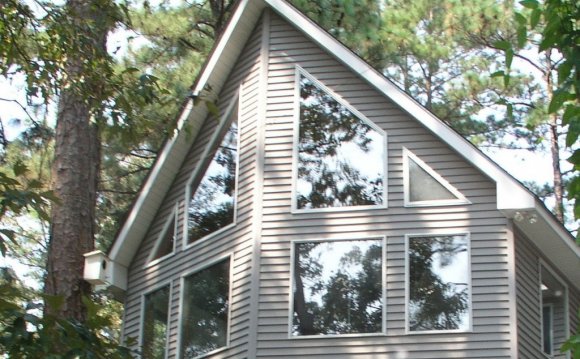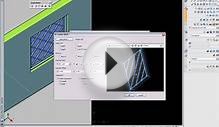
Note:Click thumbnails for larger images.
Bays The number of bays refers to the width of a building by counting the number of opennings including both doors and windows. A house with a center door and a window on either side has 3 BAYS.Belfry A small square bell tower placed atop a roof to house a bell, often found on churches and schools. Board and Batten A construction method for doors or walls in which the wood is arranged in vertical boards and held in place with a horizontal board called a batten. Brackets Ornamental supports, usually of wood or pressed metal, which appear at the cornice line of a building. They may be incised into a scrolled patten or be more simply molded and are common to all Italinate style buildings, but often appear with other styles as well. Bulkhead A bulkhead is a set of metal door providing an outdoor entrance to the cellar. Buttress A wall support usually of stone or brick placed at the sides of a building, commonly seen on some Gothic Revival style churches. Chair Rail A chair rail is decorative wooden trim attached horizontally at the approximate height of the back of a straight chair. Chimneys Chimneys are usually built of stone or brick (more modern chimneys may be of cinder block) and are located at either the exterior side walls of the building or at the center or interior of the building. Certain vernacular folk building patterns locate the chimney at the center of the house or at the corner. Clapboard A narrow wooden board, thinner at one edge than the other, applied horizontally to the exterior walls of buildings to form a weather-tight wall surface. Column A support pillar, usually round, found on porches and as a decorative detail.
Column Capitals Capitals are the tops of round columns and may be of several distinct types or orders. Greek Doric capitals are fluted and plain, Roman Doric capitals are smooth and plain, Ionic capitals have a rams horns at all four corners, and a Corinthian capital is highly decorative with curling acanthus leaves.
Coping The capping at the top of a wall for protection from weather elements. Corbel A decorative use of brick atop the windows, walls or chimney or to create the shape of a bracket or dentil at the top of a building beneath the cornice. Cornice A cornice is the finished edge of the roof where it meets the exterior wall, of varying sizes, sometime plain, but often decorative and marked by brackets, dentils, medalions or some other decorative feature.
Crenelated Parapet A low retaining wall at the edge of a roof or porch with a uniform pattern of openings creating a battlement. In medieval times the openings were used for the defense of fortresses, hence the term battlement. Cresting Roof cresting is a lacy decorative fencing made of wrought iron, rimming the edge or peak of a roof, often seen in Second Empire (Mansard) style buildings. Cupola A cupola is a decorative, small, projecting tower at the top of the roof of a building, often square, round or ocatagonal in shape. Dormer A window opening at the roof level, topped by a front gable or shed roof.
Eaves The edge of the roof that overhangs the exterior walls, sometimes with exposed rafters. Eyelid Dormer A half-elliptical decorative window placed in the roof surface, resembling the shape of an eye. Facade The face of a building, usually referring to the front. Fanligh A semi-circular (fan shaped) window placed atop a door, commonly seen in Federal and Colonial Revival style buildings. Fenestration Pattern The arrangement of windows across the facade of a building. Finial A decorative piece set atop a spire, cupola, gable or gate post. Flemish Gable A decorative gable form, often seen in Flanders and the Netherlands, the sides of which drop in a cascade of right angles, also called a crow-stepped gable. Used as a decorative embellishment in Victorian era styles in the USA. Floor Plan The layout of the various levels of a building, showing the location of rooms, interior walls, chimneys, porches and staircases. Fluting Fluting is a decorative finish for wooden columns or trim where parallel grooves are carved vertically along the surface. Frieze A frieze is the panel beneath the cornice at the top of a building' exterior wall which is often ornamented with brackets, dentils or modallions. Lintel The flat horizontal piece at the top of a window. Masonry A type of construction using stone, brick, tile or concrete block using mortar. Molding A decorative raised surface along the edge of an architectural feature such as a window, column, door or wall. Mortar A mixture of sand, water, lime and cement used to lay bricks, stone, tile or concrete block. Mullions The wooden divisions between panes of glass on windows. Ogee Arch A center pointed arch with reverse curve sides, often seen on Exotic Moorish Revival style buildings. Oriel Window A projecting bay window supported by brackets or a triangual support piece. Palladian Window A three-part, round-arched window, named for the 15th century Italian architect Andreas Palladino, also known as a Venetian Window and common in the Georgian and Colonial Revival styles. Parapet A parapet is a low stone or brick wall at the top of a building. A crenelated parapet has rhythmic breaks in the wall to create a pattern of battlements. Pediment A triangular space created by a front facing gable roof, often seen in Classical Revivial style buildings. Pendant An ornamental piece of wood or metal hanging down from a porch, cornice or bracket. Pent Roof A narrow shed style roof placed above the first floor of a building to protect the doors, windows and lower walls, often covering all four sides of the building. Pilar A support column without classical detailing. Pilaster A pilaster is a narrowly protruding column attached to a wall, giving the illusion of a real free standing support column. Pointed Arch An arch with a strong center point, usually seen in Gothic Revival style buildings. Porch A roofed space outside the mains support walls of a building. Portico A small entrance porch. Quoins Quoins are decorative rectangles or squares of stone, brick, wood or concrete, placed at the corners of buildings to add architectural interest.
Rafters The wooden structural support beams for a roof, sometimes visible on the exterior for certain building types and styles. Roof Roofs can be steep, flat or gently sloped and take many forms, gable, gambrel, hipped, stepped gable, shed, pent or Mansard. The roof type is an important key to identifying the style of a building.
Source: www.phmc.state.pa.us
RELATED VIDEO

ARCHICAD 19 New Features - New Label Types: Door Window Stamp

Custom Doors and Windows in AutoCAD Architecture

How to get Architecture type on Windows (32/64-bit)









